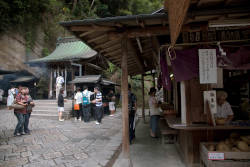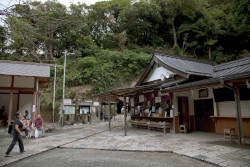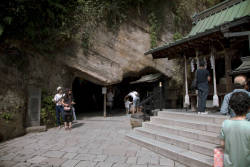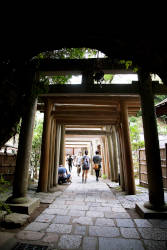銭洗弁財天宇賀福神社
Zeniarai Benzaiten Ugafuku Shrine
Useful Information


| Location: |
2 Chome-25-16 Sasuke, Kamakura, Kanagawa 248-0017.
(35.325699, 139.542206) |
| Open: |
All year daily 8-16:30. [2022] |
| Fee: |
free. [2022] |
| Classification: |
 Cave Church Cave Church
|
| Light: |
 Electric Light Electric Light
|
| Dimension: | |
| Guided tours: | self guided |
| Photography: | allowed |
| Accessibility: | yes |
| Bibliography: | |
| Address: | Zeniarai Benzaiten Ugafuku Shrine, 2 Chome-25-16 Sasuke, Kamakura, Kanagawa 248-0017, Tel: +81-467-25-1081. |
| As far as we know this information was accurate when it was published (see years in brackets), but may have changed since then. Please check rates and details directly with the companies in question if you need more recent info. |
|
History
| 1185 | Zeniarai Benzaiten founded after Minamoto no Yoritomo (1147–1199), first of the Kamakura shōguns, on the day of the Snake in the month of the Snake dreamed of kami Ugafukujin. |
| 1257 | tradition of washing money at the spring in the hope of seeing it multiply born. |
| 1958 | tunnel built and became convenient main entrance. |
Description


銭洗弁財天宇賀福神社 (Zeniarai Benzaiten Ugafuku Shrine) is really a tongue twister, even for Japanese, so the temple is simply called Zeniarai Benten. The Shinto shrine it is the second most popular spot in Kamakura, despite its small size. It is popular among tourists because the waters of the spring in the cave are said to multiply the money washed in it.
Actually 宇賀福神 (Ugafukujin) is just another name for 弁才天 or 弁財天 (Benzaiten), the goddess of everything that flows: water, time, words, speech, eloquence, music, and knowledge. Benzaiten is a syncretic entity with both a Buddhist and a Shinto aspect. The Japanese Buddhist goddess originated from the Hindu goddess Saraswati. The Sutra of Golden Light has a section devoted to her. This shrine is one of the last in Japan, which still shows the fusion of native religious beliefs and foreign Buddhism.
Zeniarai Benzaiten was founded after Minamoto no Yoritomo (1147–1199), first of the Kamakura shōguns, on the day of the Snake in the month of the Snake dreamed of kami Ugafukujin. The kami told him "In a valley to the northwest, there is a miraculous spring that gushes out of the rocks. Go there and worship kami and hotoke, and peace will come to the country. I am the kami of this land, Ugakufujin." Yoritomo found the spring and built a shrine for Ugafukujin, a kami whose symbol is a snake with a human head.
Another legend tells how the tradition of washing money at the spring in the hope of seeing it multiply was born. Some say it is the reason for the shrine’s popularity. During the Edo period it was considered one of the 鎌倉五名水 (Five Famous Springs of Kamakura) and noted for the quality of the water.
In 1257 when Kamakura’s ruler Hōjō Tokiyori came here to worship. He recommended the faithful to wash their coins, saying that if they did so, they certainly would be rewarded by Ugafukujin, who would multiply them and grant their descendants prosperity. He himself did so, and people started imitating him, starting a tradition which continues to this day. The spring was called 銭洗水 (Zeniarai-mizu, money washing water).
The shrine is completely surrounded by high rock walls. Zeniarai Benzaiten can be reached only through a tunnel and a narrow trail on the other side. It is completely invisible from the outside. The 奥宮 (Okugū), dedicated to Ugafukujin/Benzaiten, is the most visited hall and is not a building but a cave. The famous spring is inside the cave. Sieves are available from the shrine counter for a small fee, so the faithful can wash their bills and coins.
We are not sure if the cave is natural or artificial. The access tunnel is obviously artificial, but the cave seems to be a natural cave created by the erosion of the spring water. We guess the original cave was widened artificially for the use as a shrine.
- See also
 Search DuckDuckGo for "Zeniarai Benzaiten Ugafuku Shrine"
Search DuckDuckGo for "Zeniarai Benzaiten Ugafuku Shrine" Google Earth Placemark
Google Earth Placemark Zeniarai Benzaiten Ugafuku Shrine - Wikipedia (visited: 13-FEB-2022)
Zeniarai Benzaiten Ugafuku Shrine - Wikipedia (visited: 13-FEB-2022) 銭洗弁財天宇賀福神社 (ぜにあらいべんざいてんうがふくじんじゃ), official website
銭洗弁財天宇賀福神社 (ぜにあらいべんざいてんうがふくじんじゃ), official website  (visited: 13-FEB-2022)
(visited: 13-FEB-2022) Zeniarai Benten Shrine (visited: 13-FEB-2022)
Zeniarai Benten Shrine (visited: 13-FEB-2022) Zeniarai Benzaiten Ugafuku Shrine - The Miraculous Water Of Kamakura (visited: 13-FEB-2022)
Zeniarai Benzaiten Ugafuku Shrine - The Miraculous Water Of Kamakura (visited: 13-FEB-2022) Zeniarai Benzaiten Ugafuku Shrine (visited: 13-FEB-2022)
Zeniarai Benzaiten Ugafuku Shrine (visited: 13-FEB-2022)
 Index
Index Topics
Topics Hierarchical
Hierarchical Countries
Countries Maps
Maps